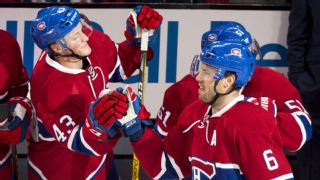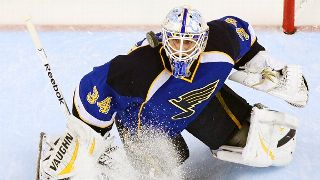|
During one of the most eventful offseasons in recent memory, several teams appeared determined to shake things up. That meant shuffling their rosters and instituting new team philosophies. Whether it was the Edmonton Oilers christening their new $600 million arena by naming Connor McDavid the youngest captain in NHL history or the Tampa Bay Lightning maneuvering for months to retain their young core by re-signing Steven Stamkos, Victor Hedman and Nikita Kucherov, there has been no shortage of intrigue these past few months. When it came to real roster reconstruction, our teams -- one from each division -- truly pivoted. Have those drastic changes positioned them for a Stanley Cup run? Atlantic DivisionMontreal Canadiens: No move was discussed more over the course of this wild summer than the one-for-one swap of All-Star defensemen P.K. Subban and Shea Weber on June 29. The deal sent shockwaves through the hockey world and left outraged Canadiens fans mourning the loss of Subban, a charismatic showman who had quickly become one of the most popular players in the team's lengthy history.  The trade personified what general manager Marc Bergevin and coach Michel Therrien wanted to do with the club that started 9-0-0 last season before heading into freefall after franchise goalie Carey Price was lost to a knee injury in November. The Canadiens clearly wanted to get tougher and be more intimidating, and the acquisition of Weber certainly helped serve that purpose. Add the trade that brought hard-nosed forward Andrew Shaw from the Chicago Blackhawks as well as the signing of 6-foot-1 KHL star Alexander Radulov, and the Canadiens have become a far more difficult matchup. "I just think it's a better team in the true sense of the word. At least on paper," said former Canadiens player and current broadcaster Chris Nilan. "I truly believe the guys they brought in -- Weber and Shaw -- come as advertised. They are good character guys and good team players and they know how to win." Metropolitan DivisionNew York Rangers: A variety of teams in the Metro Division made intriguing alterations to their rosters -- the lone exceptions being the Pittsburgh Penguins and Washington Capitals, two teams with no intentions of messing with success. The Rangers, on the other hand, made wholesale changes to a roster that was teeming with talent before being dominated by the Penguins in the opening round of the playoffs. Just over a year after becoming the Rangers' general manager, Jeff Gorton has clearly put his fingerprints on this team. "You see the change in management. Jeff Gorton now has the team to himself. That's a big thing," said former Rangers GM Neil Smith. "The Rangers are doing what a lot of teams are doing. They're trying to bring in young players who will eventually be their upper-echelon players." Despite going four years without a first-round pick, the Rangers still managed to get younger. It started with signing Jimmy Vesey, the free agent who won the Hobey Baker last season as the best player in Division I hockey. Coming on the heels of signing Kevin Hayes last season, it marked the second straight year the Rangers have reeled in college hockey's top free agent. Between Vesey, rookie Pavel Buchnevich and Mika Zibanejad, who was acquired from the Ottawa Senators for veteran center Derick Brassard, the Rangers' top six forwards could feature three new players aged 23 or younger.  Central DivisionSt. Louis Blues: Long a picture of consistency built around a reliable veteran core, the Blues decided to shake things up in the summer. The first major change came courtesy of longtime captain David Backes, who was not brought back before signing as a free agent with the Boston Bruins. Other veteran forwards who left in free agency included Troy Brouwer and Steve Ott, essentially turning that unit over to dynamic young players Vladimir Tarasenko, Jaden Schwartz, Robby Fabbri and the recently acquired Nail Yakupov. But the biggest change in St. Louis might have been the trade of goaltender Brian Elliott to the Calgary Flames, leaving the crease to 26-year-old Jake Allen. With that, Allen officially becomes the undisputed No. 1 after splitting duties with Elliott the past two seasons. "They feel that he is ready to carry the load for them. They obviously have the confidence in him," said former Blue Ron Sutter, who currently serves as the Flames' director of player development. "It's not a negative to Brian Elliott. You're just getting a younger, proven goalie who is going to cost them a lot less money." Pacific DivisionArizona Coyotes: The Coyotes got the offseason buzzing early when they made 26-year-old John Chayka the youngest general manager in NHL history. The front office wasn't the only area where the Coyotes got younger. A year after rookies Max Domi and Anthony Duclair officially kicked off the team's youth movement, Chayka and the Coyotes continued to follow that trend. Gone are veterans Antoine Vermette, Kyle Chipchura, Boyd Gordon and Nicklas Grossmann. They've effectively been replaced by four rookies in Dylan Strome, Christian Dvorak, Lawson Crouse and Jakob Chychrun. Dvorak, 20, is the oldest of the group. The Coyotes also added much-needed veteran help through free agency by signing Alex Goligoski, Radim Vrbata, Jamie McGinn, Ryan White and Luke Schenn. At age 40, captain Shane Doan will remain an important source of leadership. But there's one star on the blue line who could prove just as invaluable if the new-look Coyotes want to take the next step. "Oliver Ekman-Larsson is an elite player," said Sutter. "I think it's just a matter of surrounding those young guys with more of the middle-age guys. Ekman-Larsson is moving into that middle age group now. He's certainly a great role model for the young kids on that team."
|

